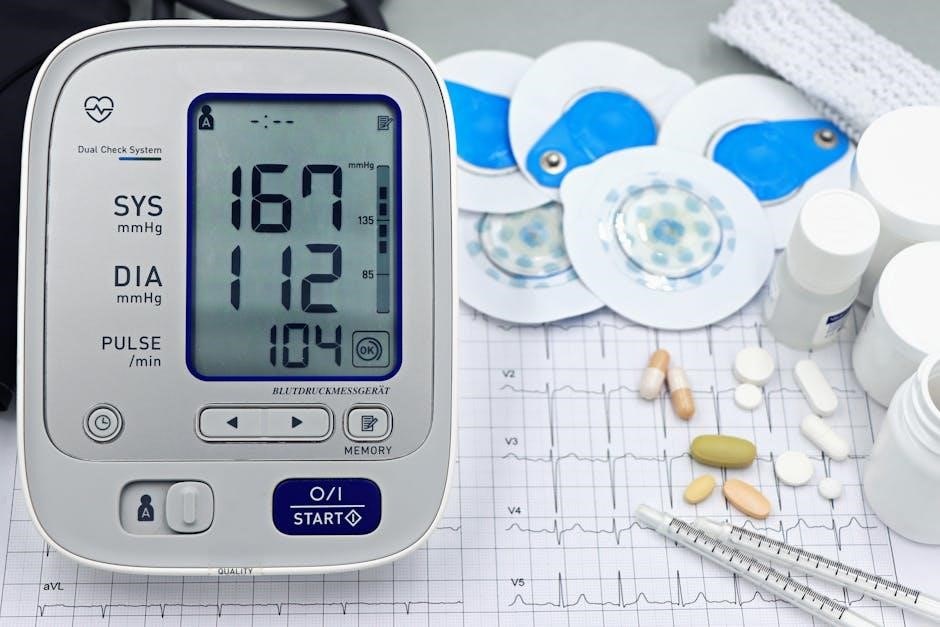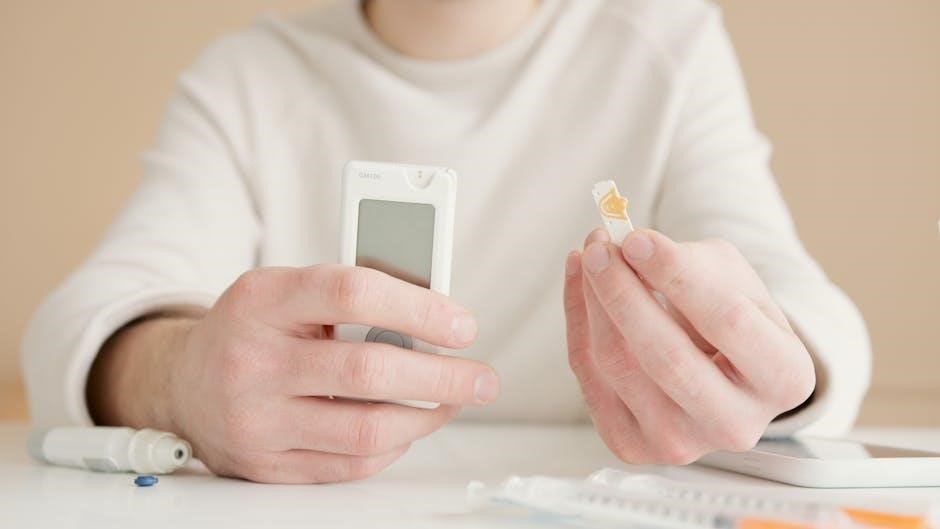
A diabetic foot exam is a critical assessment for early detection of foot-related complications in individuals with diabetes‚ emphasizing prevention and timely intervention to improve outcomes.
1.1 Definition and Importance
A diabetic foot exam is a comprehensive evaluation of the feet in individuals with diabetes‚ focusing on detecting complications like ulcers‚ neuropathy‚ and peripheral artery disease. It is essential for early identification of high-risk conditions that could lead to severe outcomes if untreated. Regular exams help prevent amputations‚ improve wound healing‚ and enhance overall foot health. The exam is a cornerstone in diabetes management‚ ensuring timely intervention and personalized care plans. Adherence to clinical guidelines ensures standardized and effective assessments‚ ultimately improving patient outcomes and quality of life. Regular foot exams are vital for all diabetic patients to maintain mobility and prevent complications.
1.2 Purpose of the Exam
The primary purpose of a diabetic foot exam is to identify risk factors and detect early signs of foot complications‚ enabling prompt treatment and prevention of severe outcomes. It aims to assess neuropathy‚ circulation‚ and structural abnormalities‚ ensuring early intervention to avoid ulcers‚ infections‚ and amputations. Regular exams also promote patient education on foot care‚ encouraging proactive self-management. By identifying high-risk patients‚ healthcare providers can tailor monitoring and preventive measures‚ improving long-term outcomes and reducing the burden of diabetes-related complications. The exam serves as a critical tool in maintaining foot health and overall well-being for individuals with diabetes.

Clinical Practice Guidelines for Diabetic Foot Care
Clinical practice guidelines for diabetic foot care provide evidence-based recommendations to improve diagnosis‚ treatment‚ and management‚ ensuring better outcomes for patients with diabetic foot complications.
2.1 Overview of Guidelines
Clinical practice guidelines for diabetic foot care provide a comprehensive framework to manage and prevent complications. They emphasize early detection through annual foot exams‚ proper wound care‚ and infection control. Guidelines also stress the importance of multidisciplinary approaches‚ involving healthcare providers‚ podiatrists‚ and educators. Evidence-based recommendations include regular screening for neuropathy and peripheral arterial disease‚ use of monofilament testing‚ and appropriate debridement. These guidelines aim to standardize care‚ reduce amputation rates‚ and improve quality of life for individuals with diabetes. Adherence to these guidelines ensures consistent‚ high-quality management of diabetic foot syndrome globally.
2.2 Role of Healthcare Providers
Healthcare providers play a pivotal role in managing diabetic foot syndrome through early detection‚ education‚ and coordinated care. They perform comprehensive foot exams‚ assess neuropathy‚ and check for peripheral arterial disease. Providers educate patients on self-care practices‚ such as proper foot hygiene and footwear selection. They also ensure timely interventions‚ including wound debridement and infection control. Collaboration within a multidisciplinary team is essential to address complex cases effectively. By adhering to clinical guidelines‚ healthcare providers can significantly reduce the risk of complications‚ improve patient outcomes‚ and enhance quality of life for individuals with diabetes. Their role is central to preventing amputations and promoting overall well-being.

Risk Factors for Diabetic Foot Syndrome
Diabetes mellitus‚ neuropathy‚ and peripheral arterial disease are key risk factors. Poor glycemic control‚ foot deformities‚ and lifestyle factors also contribute to the development of diabetic foot syndrome.
3.1 Diabetes Mellitus and Neuropathy
Diabetes mellitus is a primary risk factor for diabetic foot syndrome‚ often complicated by neuropathy. High blood sugar levels over time damage nerve fibers‚ leading to loss of sensation; This neuropathy increases the risk of unnoticed foot injuries‚ which can progress to infections and ulcers. Diabetic neuropathy also impairs wound healing. Early detection through nerve conduction tests and monofilament testing is crucial. Managing blood sugar levels and addressing neuropathy are essential to prevent diabetic foot complications and improve patient outcomes. Regular foot exams help identify early signs of neuropathy and related issues.

3.2 Peripheral Arterial Disease
Peripheral arterial disease (PAD) is a significant risk factor for diabetic foot syndrome‚ often coexisting with diabetes. PAD reduces blood flow to the lower extremities‚ impairing wound healing and increasing the risk of infections. Symptoms include leg pain‚ cold feet‚ and weak pedal pulses. Diabetic patients with PAD are at higher risk for foot ulcers and amputations. Early detection through Doppler ultrasound and angiography is vital. Managing PAD involves lifestyle changes‚ medication‚ and revascularization to restore blood flow. Regular screening and prompt intervention are crucial to prevent severe complications and improve outcomes for diabetic foot care.

Examination Techniques
Regular diabetic foot exams involve comprehensive assessments‚ including physical inspections‚ neuropathy screening‚ and circulatory checks‚ to ensure early detection and management of potential complications.

4.1 Physical Examination
A thorough physical examination is essential for assessing diabetic foot health. It begins with a visual inspection to identify skin changes‚ such as calluses‚ ulcers‚ or signs of infection. Palpation is used to detect abnormalities in tissue texture or temperature; Peripheral pulses are checked to evaluate blood flow‚ with diminished or absent pulses indicating potential arterial disease. The examination also assesses for deformities‚ such as hammertoes or Charcot foot‚ which can increase the risk of complications. These steps help identify early signs of neuropathy and vascular issues‚ enabling timely interventions to prevent progression and improve patient outcomes.
4.2 Use of Monofilament Testing
Monofilament testing is a standardized method to assess sensory loss in diabetic patients. A 10-gram monofilament is applied to specific points on the foot to evaluate perception. If the patient cannot feel the filament‚ it indicates loss of protective sensation‚ a hallmark of neuropathy. This test is crucial for early detection of neuropathy and helps identify patients at risk of foot ulcers. Regular monofilament testing is recommended as part of routine diabetic foot exams to guide management and prevention strategies‚ ensuring early intervention and reducing the risk of complications. It is a simple yet effective tool in clinical practice.

Management and Treatment
Management of diabetic foot involves wound care‚ infection control‚ and debridement. A multidisciplinary approach ensures effective treatment‚ improving outcomes and reducing complications in diabetic patients.
5.1 Infection Control
Infection control is critical in managing diabetic foot syndrome. Prompt evaluation and treatment of infections are essential to prevent progression. Clinical guidelines recommend sharp debridement of infected tissue and appropriate antibiotic therapy. Regular wound dressings and off-loading pressure are vital to promote healing. Proper hygiene practices should be emphasized to reduce the risk of infection spread. Early identification of signs of infection‚ such as redness‚ swelling‚ or pus‚ is key to effective management. A multidisciplinary approach ensures comprehensive care‚ improving patient outcomes and reducing complications. Adherence to evidence-based protocols is essential for optimal infection control in diabetic foot care.
5.2 Wound Care and Debridement
Effective wound care and debridement are essential for managing diabetic foot ulcers. Sharp debridement is recommended for removing necrotic tissue‚ promoting healing‚ and preventing infection spread. This procedure should be performed by trained healthcare professionals. Wound care involves maintaining a clean‚ moist environment to foster granulation tissue growth. Dressings like hydrogels or foams are commonly used. Regular monitoring and documentation of wound size‚ depth‚ and appearance are crucial for tracking progress. Off-loading pressure and managing edema are also critical components of wound care. Compression therapy may be applied to enhance blood flow. Patient education on wound care practices is vital for improving outcomes and preventing complications.

Prevention Strategies
Prevention strategies for diabetic foot complications emphasize regular foot inspections‚ proper footwear‚ and patient education on self-care. Early detection and intervention are key to improving outcomes.
6.1 Foot Self-Care Education
Foot self-care education is essential for individuals with diabetes to prevent complications. It involves teaching patients to inspect their feet daily for signs of injury or infection‚ such as cuts‚ bruises‚ or redness. Proper hygiene practices‚ like washing and drying feet thoroughly‚ are emphasized. Patients should also learn to avoid harmful practices‚ such as walking barefoot or using harsh chemical products. Education on proper footwear selection is crucial to prevent pressure points and friction. Healthcare providers play a key role in reinforcing these habits‚ ensuring patients understand the importance of proactive care in managing diabetic foot syndrome effectively.
6.2 Regular Screening and Monitoring
Regular screening and monitoring are vital for early detection of diabetic foot complications. Annual foot inspections by healthcare professionals are recommended‚ focusing on signs of neuropathy‚ peripheral arterial disease‚ and structural abnormalities. Patients should be assessed for loss of protective sensation using monofilament testing and palpation of pedal pulses. High-risk patients may require more frequent evaluations. Monitoring includes tracking foot temperature‚ wound healing progress‚ and glycemic control. These measures ensure timely interventions‚ reducing the risk of severe complications like ulcers and amputations. Compliance with screening schedules significantly improves outcomes and is a cornerstone of diabetic foot care management.

Multidisciplinary Approach
A multidisciplinary approach is essential for managing diabetic foot care‚ involving podiatrists‚ endocrinologists‚ nurses‚ and surgeons to ensure comprehensive and coordinated patient management‚ improving outcomes and reducing complications.
7.1 Team Collaboration
Effective team collaboration is vital in managing diabetic foot care. A coordinated effort among healthcare professionals‚ including podiatrists‚ endocrinologists‚ nurses‚ and surgeons‚ ensures comprehensive patient management. Each specialist brings unique expertise‚ fostering a holistic approach to diagnosis‚ treatment‚ and prevention. Regular communication and shared decision-making are key to addressing complex cases and improving patient outcomes. Collaborative care models have been shown to reduce amputation rates and enhance quality of life for individuals with diabetic foot complications. By integrating diverse skills‚ the team ensures seamless care delivery‚ from early detection to advanced interventions‚ ultimately benefiting patient health and well-being.
7;2 Patient Education
Patient education is a cornerstone of diabetic foot care‚ empowering individuals to take an active role in managing their condition. Education focuses on recognizing early signs of foot complications‚ such as ulcers or discoloration‚ and the importance of proper footwear. Emphasizing daily foot inspections and hygiene practices helps prevent infections. Patients are also taught to avoid harmful behaviors‚ like walking barefoot‚ and to monitor blood sugar levels to reduce neuropathy risks. Educational resources‚ including guides and visual aids‚ are often provided to enhance understanding. By fostering awareness and self-care‚ patient education significantly improves long-term outcomes and reduces the likelihood of severe complications.